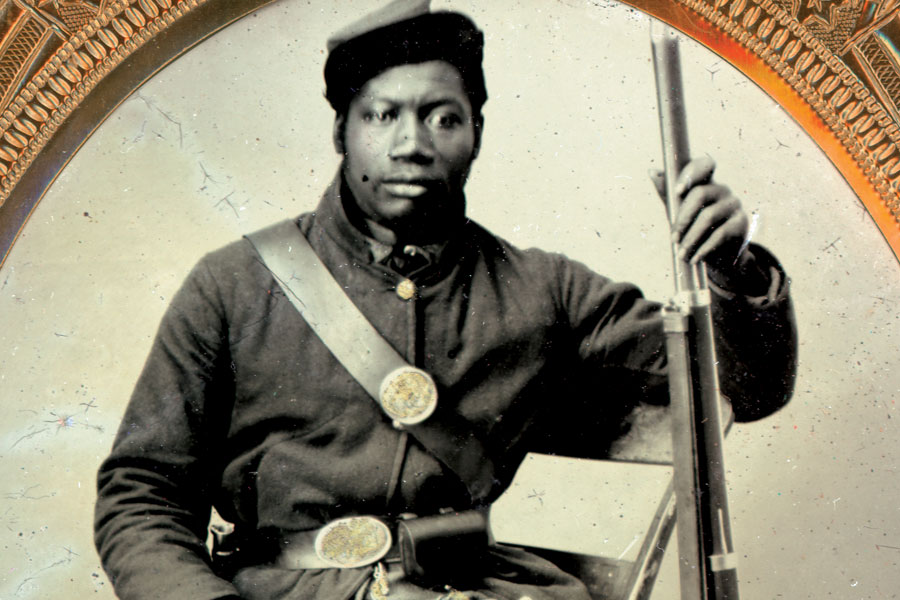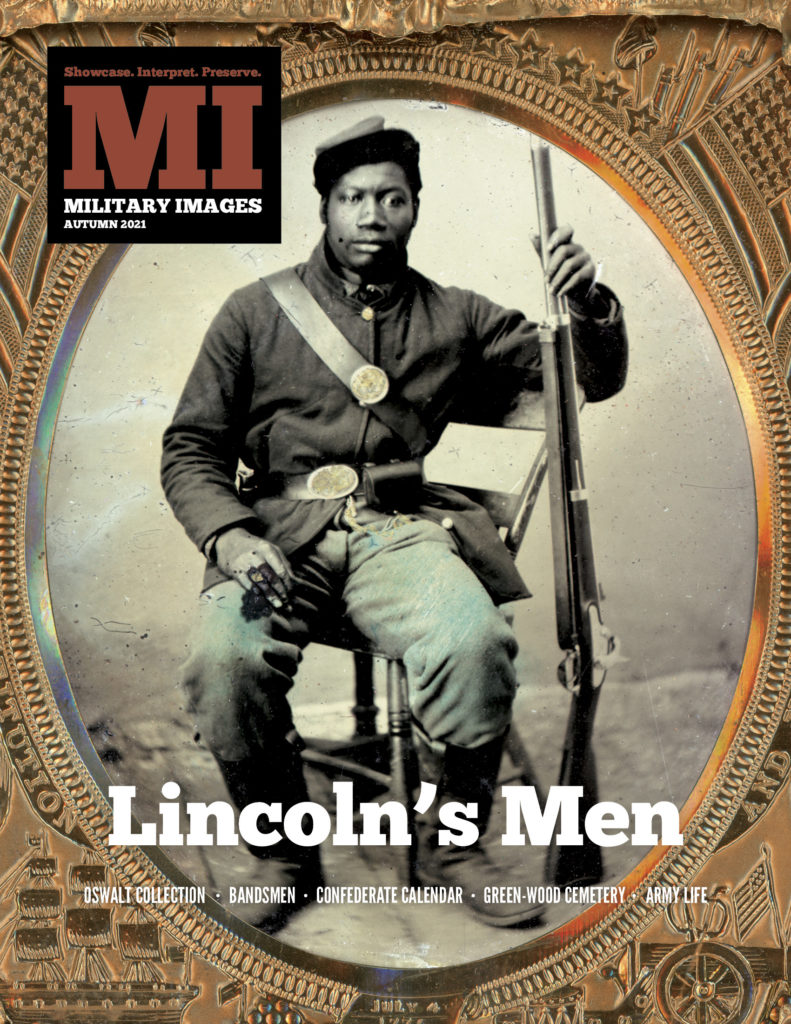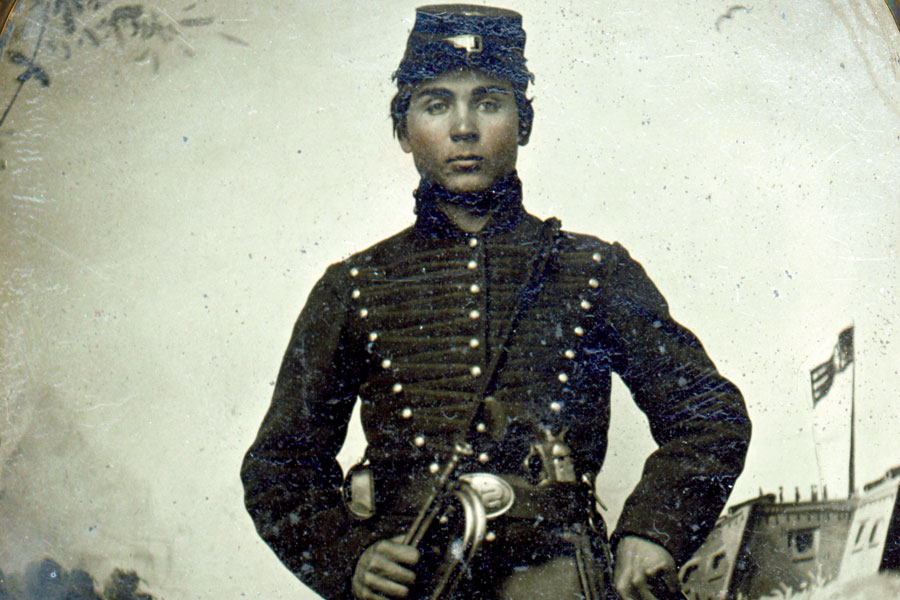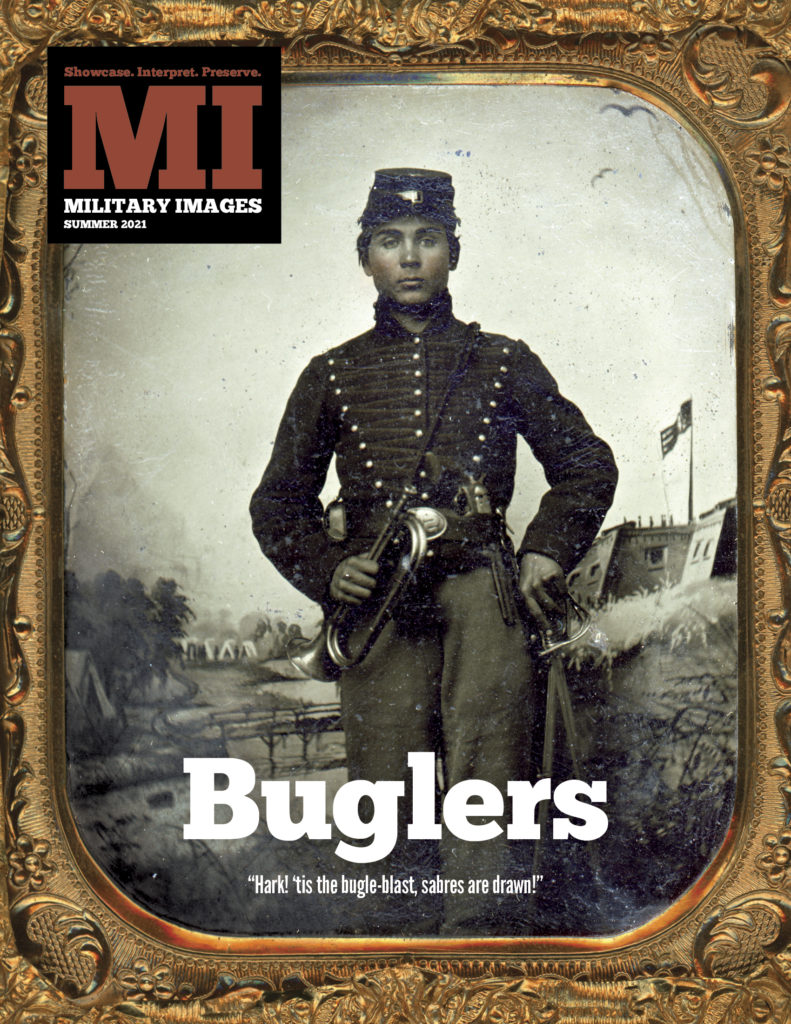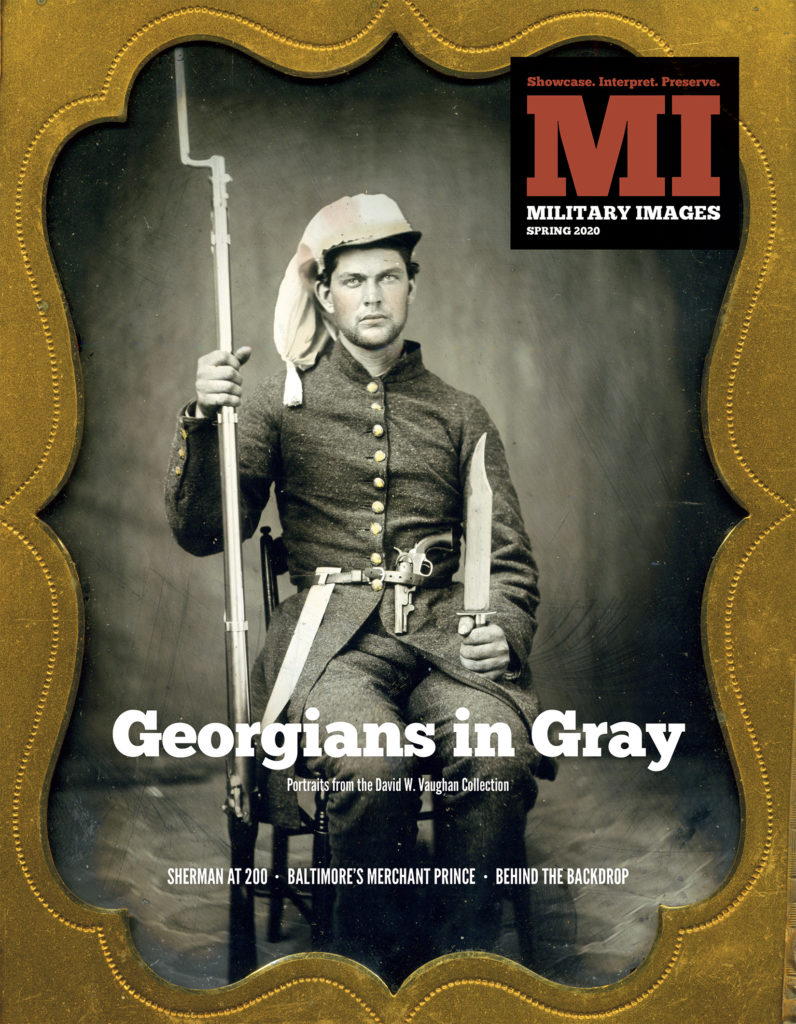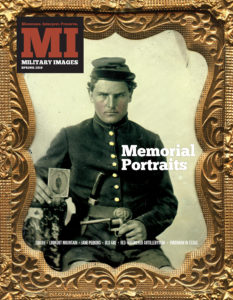A complete table of contents for the Autumn 2021 issue of Military Images magazine, and information about how to purchase single issues and subscriptions.
Vol. XXXIX, No. 4
(80 pages)
Print edition: Visit our store to check availability
Digital edition: Visit JSTOR.org to purchase
Subscribe to MI
Explore the MI Archives:
Browse | Advanced search | Tutorial
Inside
Cover image
A sixth-plate tintype from the Dan Schwab Collection pictures a U.S. Colored Infantryman.
Table of Contents (p. 1)
Editor’s Desk (p. 2)
In “A Word About Mail Delivery,” the editor shares details about the history of the U.S. Post Office’s periodicals rate.
Mail Call (pp. 3-4)
Feedback includes praise for the gallery of buglers, a memorial to Trevor Boeve, a journey to recognize the grave of a Civil War veteran, and notes on fluted Colt Revolvers and Maynard Carbines.
Military Anthropologist (p. 4)
A breakdown of Medals of Honor awarded to Union army soldiers, by rank.
Passing in Review (p. 6)
Two books are reviewed: Colonel Mobley: The 7th Maryland Infantry in the Civil War by Justin T. Mayhew (self-published) and Military Prisons of the Civil War: A Comparative Study by David L. Keller (Westholme Publishing).
Photo Sleuth by Kurt Luther (pp. 8-10)
In “Civil War Photo Sleuth Goes Social,” Luther provides information about several new features that focus on collaboration and community.
Antebellum Warriors (p. 12)
A sixth plate daguerreotype features a soldier dressed in a uniform with hints of militia and regular army from the Mexican War to early 1850s era.
Most Hallowed Ground (p. 14)
Pvt. Oliver Gardner of the 3rd Michigan Infantry survived a wound at the Battle of Gettysburg but succumbed to injuries sustained during the Battle of The Wilderness. He is buried in Arlington National Cemetery.
The Honored Few (p. 16)
Maj. John Curtis Gilmore of the 16th New York Infantry put himself in harm’s way during the Battle of Salem Church when he grabbed the colors and rallied the men. His actions resulted in the Medal of Honor.
The Citizenry by Ross J. Kelbaugh (p. 18)
In “Free at Last,” the origins of a carte de visite of Freedmen on the grounds of a home is traced to Louisiana and the Baton Rouge studio of photographers McPherson and Oliver.
Bandsmen (pp. 21-35)
A gallery of 42 images collected in collaboration with Editor Dale Niesen of the Facebook group “The Image Collector” and contributions by collectors, reviewed by Jeff Stockham, is focused on musicians pictured with cornets and saxhorns.
Miniature Flags and Secession Cockades: Images from the Matthew L. Oswalt M.D. Collection (pp. 36-46)
30 representative images showcase Southern soldiers and civilians. The photographs are introduced with a biographical information of Oswalt and how he became a collector of Civil War images.
Sylvester’s War: The journey of an Indiana volunteer from Tippecanoe County to Tennessee by Ronald S. Coddington (pp. 48-51)
Wagonmaker Sylvester Leaming left his family and joined the 40th Indiana Infantry. His travels as a soldier took him to numerous battlefields, including Missionary Ridge, where a wound proved mortal. This is his story.
A Father and His Sons Fighting Together: The Drown family of the 5th Rhode Island Heavy Artillery by Norman C. Delaney (pp. 52-54)
Joshua Champlin Drown, Sr., and his sons, Joshua, Jr., and Benjamin, served and survived their Civil War military experience. This is their story.
Army Life: An essay in ambrotypes and tintypes by David B. Holcomb (pp. 55-59)
The author captures the essence of the Union soldiers’ Civil War experience in eight photographs.
Green-Wood Cemetery by Jeffrey I. Richman, with images courtesy of The Green-Wood Historic Fund Collections (pp. 61-66)
A final resting place for more than 5,000 Union and Confederate veterans in Brooklyn, N.Y., the cemetery is also distinguished as one of the earliest burial grounds in the rural cemetery movement of the early 19th century. A selection of images of Civil War soldiers interred in the historic cemetery is included here.
Groundbreaking Calendar, a Q&A with Confederate Calendar creator Lawrence T. Jones III (pp. 67-70)
In 1976, Texas photography Larry Jones of Austin, Texas, produced his first calendar with Confederate photographs. Little could he have realized that he’d continue making them for years. In this exclusive interview, Larry discusses the calendars and his lifetime of collecting.
Material Culture by Ron Field (pp. 75)
In “Navy Round Jackets,” Field provides detail about the blue cloth jackets that originate with the first U.S. Navy frigate crews in 1797.
Behind the Backdrop: Origins, artistry, and photographers by Adam Ochs Fleischer (pp. 74-75)
In “The Tiger Tree Backdrop of Kalamazoo, Michigan,” Fleischer examines the distinctive painted canvas with a striped tree and military scene. This presence of this background is a clue that the soldier pictured likely served in a small number of regiments formed in the region during the Civil War.
Stragglers: Distinctive Images from MI contributors (pp. 76-78)
Included are portraits of members of Company E, 44th New York Infantry, two members of U.S. Colored Infantry regiments, Henri B. Loomis of the 56th New York Infantry, Stephen Hannas of the 11th Virginia Infantry and a group of soldiers from the 21st Wisconsin Infantry atop Lookout Mountain, Tenn.
The Last Shot (p. 80)
A sixth plate post-mortem ambrotype pictures a Union officer in death, his body carefully cleaned and dressed.

